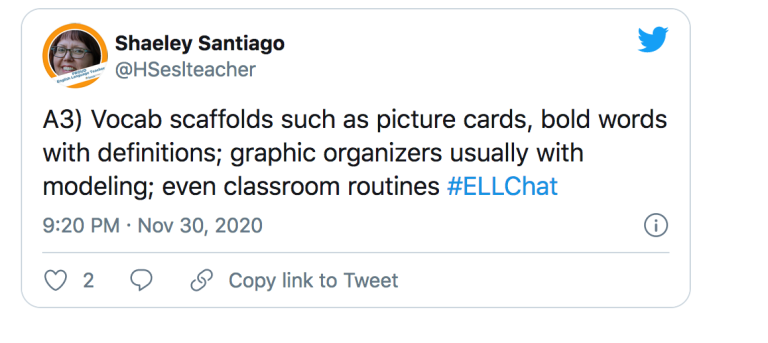6 Scaffolds for ELs in a Virtual Classroom
In May, 2020, I wrote a blog entitled “10 Scaffolds to Support EL Learning.” During a recent #ELLCHAT, a Twitter chat for teachers of English learners (ELs), we discussed scaffolds for ELs in virtual environments. The ideas that were tweeted by the participants were exceptional, and it occurred to me that the strategies mentioned in the chat would benefit all students who were learning virtually. One #ELLCHAT participant, Greg Hewley (@ghewley), a doctoral student who is currently teaching in Honduras, reported,
Confidence and well-being are so important. It is not easy for students right now and they need to feel good about learning in class. My students have been doing so well because they have scaffolds in place which lets them take chances and work on more difficult material that may be just out of reach.
This was the consensus of the group, and I’d like to share six scaffolds that were mentioned on the chat.
1) Establish Predictable Virtual Classroom Routines
Shaeley Santiago (@HSeslteach), an EL coordinator in Iowa, tweeted during the chat that classroom routines could be considered a scaffold for ELs. Zacarian et al. wrote in their 2017 book Teaching to Strengths: Supporting Students Living with Trauma, Violence, and Chronic Stress that establishing predictable routines and rituals during classroom activities is crucial for students living with trauma, violence, and chronic stress. During the past year, all of our students have been living with the uncertain nature of their lives during the pandemic. Students are afraid, depressed, and isolated from friends and school. Teachers can help by creating a virtual classroom environment that includes predictable routines, schedules, sequences, and practices, allowing traumatized students to move from an unpredictable environment to a more positive one where events happen in a routine manner.

Teachers have reported on #ELLCHAT and on other social media that they try to establish a welcoming online classroom. They begin their instruction in the same manner every day, and students and their parents have a weekly or daily schedule so that they know what will be happening during the day’s lessons. Everything should be predictable: transitions from one class to another, rules for breakout rooms, ways to communicate with classmates, and so on.
2) Increase Wait Time
Wait time is the time teachers pause between asking a question and calling on a student. Generally, teachers wait 1–3 seconds before calling on a student to answer a question. Author Melissa Kelly wrote a blog on the importance of wait time. She proposes that the length of time teachers wait affects the number of “no” or “I don’t know” responses by students. More participation and correct responses were evident when wait time is increased. This is especially important for ELs, but would affect all students. The authors of GoTo Strategies (2007) suggest waiting from 3–8 seconds when calling on ELs.
3) Employ Choral Reading and Short Plays and Skits to Encourage Increased Participation
#ELLCHAT participants found that the benefits of this were not only academic but social-emotional because ELs felt a sense of accomplishment when they participated in this activity. Brandon Beck (@BrandonBeckEDU), the author of Unlocking Unlimited Potential, mentioned music, skits, and storytelling during the chat. I noticed that my students were able to participate more fully in their general education classrooms when teachers used this strategy.
In my ESL classes, I often combined choral reading with the performance of a skit. Simple well-known skits for classics, such as “Little Red Riding Hood,” provided stories that most ELs are familiar with. With beginners, I read a simple version of the story and showed pictures to increase comprehension. Students made props for their characters and used them during the skit. The skits combined sections of choral reading with individual performances. I think this would lend itself to virtual learning and could be beneficial for all students.
4) Use Technology to Support Learning
One #ELLCHAT participant, Rachel Spangenberg (@RachelSpangenb1), an EL teacher in Iowa, leaves her Google Jamboard open with students during a live class but only shares it with ELs who benefit from this extra written support. Some teachers reported that they allow all students in a virtual classroom to interact on a Jamboard in Google Meets. Students can show their work as well as create drawings, emoji stories, and sketch notes using digital storytelling components. Ways to use Jamboards can be found on Jake Miller’s website.
5) Use Visual Learning Supports
Shaeley Santiago suggests using lots of visual supports, such as picture cards, bolded words with definitions, graphic organizers with modeling, and videos with subtitles. Shaeley mentioned that using subtitles on videos is an easy but often overlooked scaffold for ELs. She’s a big fan of icons to represent the four domains of language. For example, a megaphone for listening, pencil for writing, book for reading and face with mouth for speaking. Beth Skelton(@easkelton), an international consultant from Colorado, suggested using the Noun Project, which is an add-on for Google slides. Beth also recommends scaffolds listed on WIDA for MLLs in virtual environments.

6) Paraphrase Content Before Teaching Academic Lessons
I used this scaffold extensively when teaching fifth-grade social studies to ELs. Social studies presents many challenges for ELs, including a lack of background knowledge and the difficulty of the social studies textbooks. In order to increase comprehension, before lessons, I pretaught vocabulary and then told a story about the day’s lesson by using visual aids, photos, charts, drawings, and maps from the book. ELs learned to use the bold print, captions, titles, and subtitles to help them understand the academic content.
When I cotaught social studies with a classroom teacher, I taught a series of lessons on the growth of cities at the beginning of the 20th century. I was amazed to see how relevant my teaching techniques for ELs translated into the general education classroom.
If you have strategies that you use in your virtual classroom to scaffold EL learning, please share in the comment box below.
See our #ELLCHAT Archive mentioned in this blog.
References
Kelly, M. (2020, April 4). Wait time in education. ThoughtCo. https://www.thoughtco.com/importance-of-wait-time-8405#
New Levine, L., Lukens, L., & Ansin Smallwood, B. (2007). The GO TO strategies: Scaffolding options for teachers of English to language learners, K-12. University of Kansas City and North Kansas City Schools.
Zacarian, D., Alvarez-Diaz, L., & Haynes, J. (2017). Teaching to strengths: Supporting students living with trauma, violence, and chronic stress. ASCD

About the author
Judie Haynes
Judie Haynes taught elementary ESL for 28 years and is the author and coauthor of eight books for teachers of ELs , the most recent being “Teaching to Strengths: Supporting Students Living with Trauma, Violence and Chronic Stress“ with Debbie Zacarian and Lourdes Alvarez-Ortiz. She was a columnist for the TESOL publication "Essential Teacher" and is also cofounder and comoderator of the Twitter Chat for teachers of English learners #ELLCHAT.